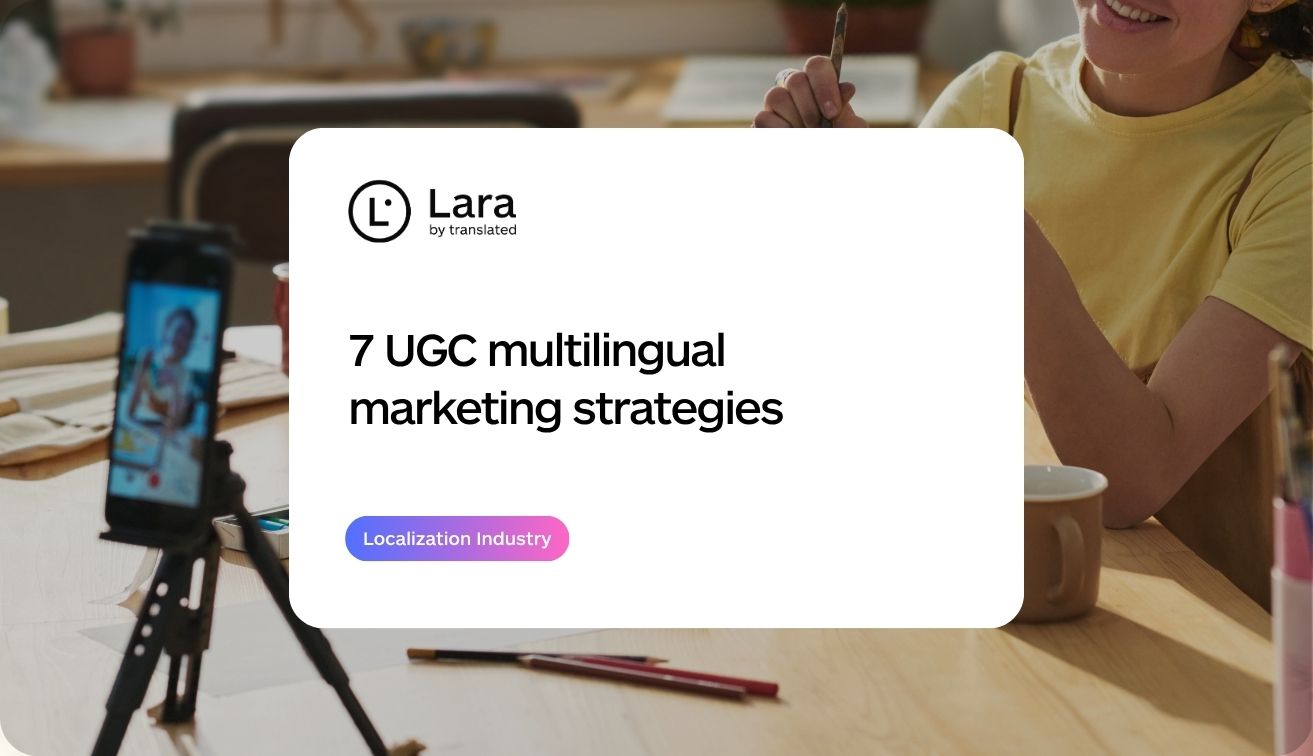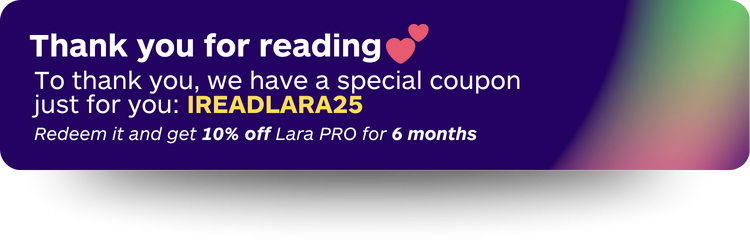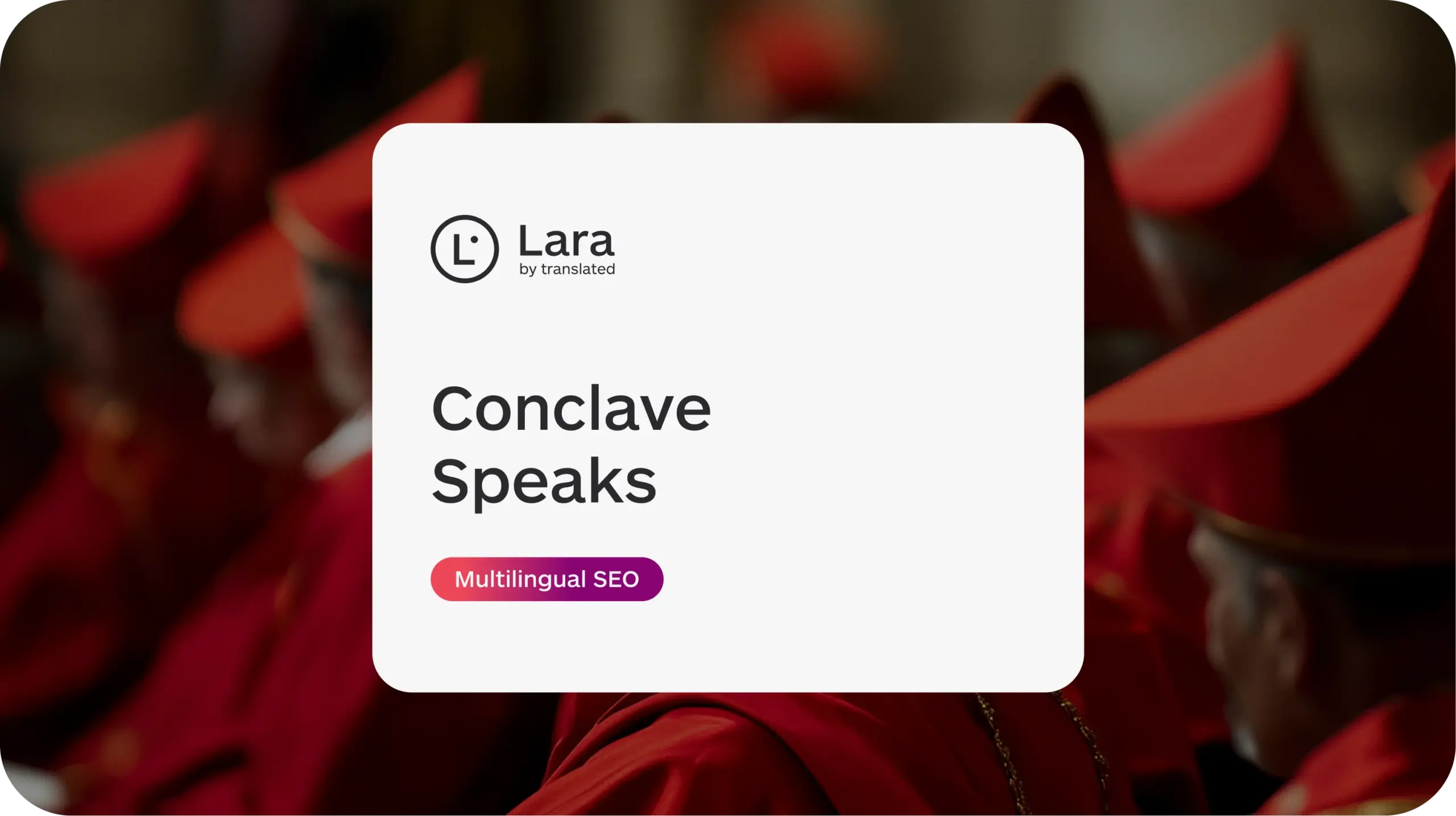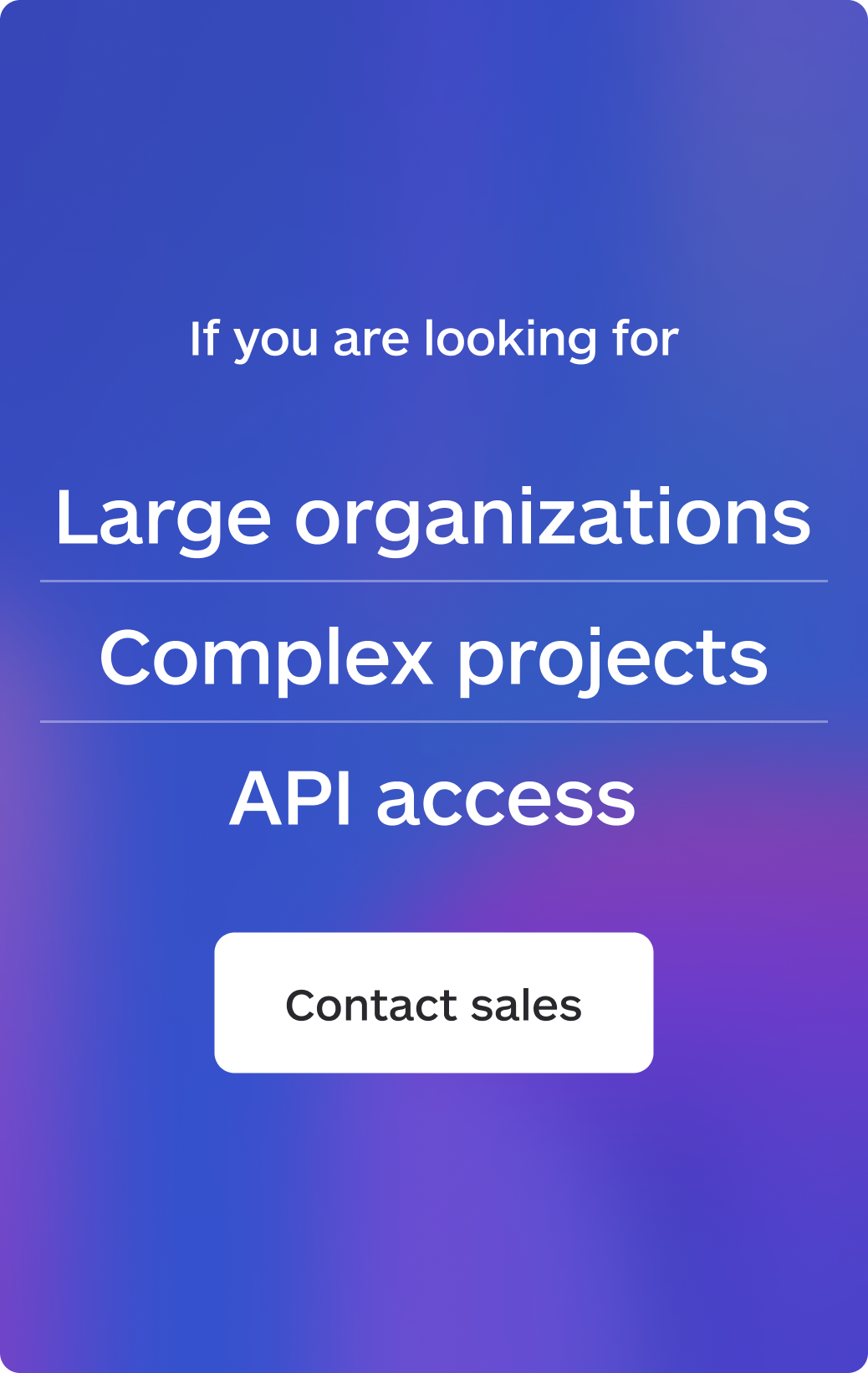User-generated content (UGC) has become an invaluable asset for marketing teams seeking to build authenticity and trust with their audiences. As brands expand into global markets, implementing effective UGC multilingual marketing strategies becomes increasingly crucial for connecting with diverse audiences in meaningful ways. This comprehensive guide explores how to run multilingual UGC campaigns and how marketing professionals can successfully source, translate, and moderate UGC across multiple languages while maintaining both authenticity and regulatory compliance.
TL;DR
|
Why UGC multilingual marketing matters
UGC is the most credible voice you do not have to write. Localizing it well lets real customers speak to new markets in their own language, which consistently lifts engagement and conversion. Doing it poorly creates risk, inconsistency, and a broken brand narrative across regions.
The explosion of user-generated content has fundamentally transformed how global brands connect with audiences across language barriers. While traditional marketing struggles to resonate across cultures, authentic user voices consistently drive higher engagement and trust in every market. Effective UGC multilingual marketing allows brands to:
- build credibility through authentic voices speaking the audience’s native language
- establish meaningful connections in new markets with culturally relevant content
- scale content creation efforts across multiple languages
- overcome cultural barriers through genuine customer experiences
So, how to run multilingual UGC campaigns? Organizations that successfully implement UGC multilingual marketing strategies can expect significantly higher engagement rates, stronger brand loyalty, and improved conversion metrics across their international markets.
Strategy 1: developing a comprehensive UGC collection framework
The foundation of successful UGC multilingual marketing begins with implementing systems to gather diverse, high-quality content across different markets and languages. Brands must establish clear processes that encourage user participation while collecting content that aligns with overall marketing objectives.
Creating market-specific collection campaigns
Different markets respond to different incentives when it comes to content creation. Marketing teams should research cultural preferences and develop targeted approaches for each region. For instance:
- in some markets, competitions with material prizes drive significant participation
- in other regions, social recognition or community status serves as a stronger motivator
- cultural preferences regarding privacy and personal exposure also vary substantially
Brands must adapt their UGC collection strategies to align with these regional variations, creating campaigns that resonate with local audiences while gathering usable content.
Implementing effective technical infrastructure
Collecting UGC across multiple languages requires robust technical infrastructure, including:
- multilingual submission forms optimized for various alphabets and character sets
- clear permission workflows in multiple languages for rights management
- metadata tagging systems that identify content language, region, and usage rights
- integration capabilities with region-specific social platforms
Organizations should invest in systems that can handle these complexities while remaining user-friendly enough to encourage participation across all target markets.
A thorough localization market research process is essential when developing market-specific UGC collection strategies. This research helps identify the platforms, incentives, and content types that will resonate most effectively with each target audience.
Example — Strategy 1: UGC collection framework
Goal: collect diverse, rights-cleared UGC in JP, DE, BR for a product launch.
- Markets & incentives: JP → recognition badge; DE → eco-impact leaderboard; BR → prize draw.
- Submission flow: localized forms (language picklist, media type, SKU) + consent for “translate” and “adapt.”
- Rights snippet: “I grant Brand the right to translate and adapt my content across languages and regions.”
- Metadata tags: lang=ja,de,pt-BR; region=JP,DE,BR; rights=translate+adapt; product=“X1.”
- Tool handoff: Route to Lara Translate project “UGC-X1-Wave1” (style=Fluid, glossary=BrandTerms v3).
- Success metric: 300 approved assets in 2 weeks; ≥30% video; 40% first-time contributors.
Strategy 2: translating UGC while preserving authenticity
Translating user-generated content presents unique challenges compared to traditional marketing materials. The informal language, cultural references, and personal voice that make UGC valuable can be difficult to preserve across language barriers. Successful UGC multilingual marketing requires specialized approaches to translation.
Balancing authenticity and clarity
When brands translate customer reviews and other UGC, they must strike a delicate balance between maintaining the authentic voice of the original creator and ensuring clarity for the target audience. This often means:
- preserving colloquialisms when they can be understood in context
- finding equivalent expressions rather than literal translations
- maintaining emotional tone even when specific references change
- adapting cultural touchpoints to resonate with the target audience
The goal is to ensure that translated UGC retains the genuine quality that makes it persuasive while still communicating effectively to the new audience.
Selecting appropriate translation methods
Different types of UGC may require different translation approaches:
- Machine translation with human review: this hybrid approach works well for high-volume content like product reviews, where advanced AI handles the initial translation, and human reviewers refine for accuracy and tone.
- Community translation: for brands with active multilingual communities, engaging users in translation can both scale efforts and add additional authenticity.
- Professional creative translation: for high-impact UGC that will be featured prominently, professional translators with expertise in creative adaptation may be necessary.
Platforms like Lara Translate offer sophisticated solutions for translating various types of user-generated content, with specialized capabilities for preserving informal language patterns and emotional nuance. With support for an expanding list of languages (see Lara’s language documentation for current offerings), brands can efficiently translate UGC while maintaining the authentic voice that makes it compelling.
Example — Strategy 2: Translate UGC without losing the voice
Scenario: casual PT-BR review with slang, to publish in ES and DE.
- Source (PT-BR): “Ficou top demais. Chegou rápido e salva meu dia.”
- Approach: Lara Translate draft (style=Fluid) → native editor for hero quotes only.
- Target ES: “Quedó buenísimo. Llegó rápido y me salva el día.” (casual tone kept)
- Target DE: “Richtig gut geworden. Kam schnell an und rettet meinen Tag.” (informal, clear)
- Glossary: keep “X1” as brand term; translate generic nouns; avoid opaque slang.
- Decision point: If used in paid ads, require native editor sign-off.
Strategy 3: implementing effective cross-language moderation
Moderating UGC becomes exponentially more complex when dealing with multiple languages. Content that seems innocuous in one language might violate cultural norms or regulations in another. Effective moderation is essential for both brand safety and legal compliance.
Establishing clear multilingual guidelines
Organizations must develop comprehensive moderation guidelines that account for linguistic and cultural variations, including:
- language-specific prohibited content and terminology
- cultural sensitivities that vary by region
- legal requirements that differ across jurisdictions
- brand-specific standards that apply universally
These guidelines should be regularly updated to reflect evolving language use and cultural norms.
Combining technological and human approaches
Effective moderation across languages typically requires a layered approach:
- Automated screening: AI-powered tools can perform initial screening across multiple languages, flagging potentially problematic content.
- Native-language human review: human moderators with cultural context should review flagged content and make nuanced decisions.
- Escalation protocols: clear processes should exist for handling edge cases or content that requires additional review.
This combined approach helps ensure that UGC multilingual marketing campaigns maintain appropriate standards while avoiding unnecessary content rejection.
Example — Strategy 3: Cross-language moderation
Scenario: Arabic and French comments on a product comparison post.
- Automated screen: flag health claims, competitor naming, and personal data (ar, fr).
- Rubric: allow personal experience; disallow medical claims; redact PII; soften competitor jabs.
- Edge case: AR idiom implying a “cure” → escalate; approve only if reframed as subjective experience.
- Audit log: store decision, locale, editor, timestamp; searchable by rule.
- SLA: 4h for flagged items; 24h for appeals.
Strategy 4: optimizing UGC display for cultural context
How user-generated content is presented should reflect the preferences and expectations of each target market. The effective display of translated UGC requires thoughtful adaptation to cultural context.
Adapting content presentation by region
Different markets often have distinct preferences regarding content presentation:
- Some cultures respond better to statistics and quantitative information
- Others place greater emphasis on personal stories and emotional connections
- Design preferences, from color schemes to layout density, vary significantly
Brands should research these preferences and adapt how UGC is displayed accordingly, ensuring that content not only speaks the right language but is presented in culturally resonant ways.
Implementing dynamic content delivery
Advanced UGC multilingual marketing strategies often involve dynamic content delivery systems that can:
- Display regionally relevant UGC based on user location
- Prioritize content from similar demographic groups
- Adjust presentation based on cultural preferences
- Test different display approaches to optimize performance
These systems ensure that each visitor sees UGC that will resonate most effectively with their specific cultural context.
Understanding the localization impact on brand perception is crucial when displaying UGC across markets.
Example — Strategy 4: Display UGC for cultural context
Scenario: same product page in US, JP, and DE markets.
- US layout: hero video testimonial → star ratings → short quotes.
- JP layout: concise quotes (polite tone), product photos with captions, community badge.
- DE layout: spec comparison table, longer review excerpts, verified purchase badge.
- Dynamic rules: geo-detect locale → serve local UGC first; reorder modules per preference.
- Test plan: A/B caption density and star icons; target +8% CTR to UGC section per locale.
Strategy 5: leveraging UGC for multilingual SEO advantage
User-generated content presents valuable opportunities for improving search visibility across multiple languages and markets. With strategic implementation, UGC multilingual marketing can substantially enhance SEO performance.
Capturing natural language search patterns
Users in different markets search in distinct ways, using colloquial phrases and regional terminology. UGC naturally incorporates these patterns, helping brands rank for searches they might otherwise miss with only professionally produced content.
To maximize this benefit, organizations should:
- Analyze UGC for emerging search terms and regional variations
- Incorporate high-performing terms into structured content
- Create connections between related UGC across languages
- Develop FAQ content based on common user questions
Implementing technical SEO best practices for multilingual UGC
To ensure search engines properly index and rank translated UGC, technical implementation is critical:
- implement proper hreflang tags to indicate language variations
- structure URLs to clearly indicate language versions
- use appropriate schema markup for reviews and other UGC
- ensure proper canonicalization to prevent duplicate content issues
When properly implemented, these technical elements ensure that UGC multilingual marketing efforts contribute to improved search performance across all target markets.
Example — Strategy 5: UGC for multilingual SEO
Scenario: ES and IT customers use different everyday terms for the same feature.
- Mining: ES → “modo ahorro”; IT → “risparmio batteria.”
- Action: add localized FAQ blocks using these phrases; tag matching reviews; cluster links per locale.
- Technical: /es/faq/modo-ahorro and /it/faq/risparmio-batteria with hreflang + review schema.
- Outcome: +15% impressions on non-brand long-tail in 45 days.
Strategy 6: ensuring legal compliance across markets
UGC multilingual marketing must navigate varying regulatory requirements across different jurisdictions. From privacy laws to disclosure requirements, brands must ensure compliance in each market they enter.
Managing rights and permissions
Content rights management becomes more complex in multilingual contexts:
- permission requirements vary by jurisdiction
- translation may constitute a derivative work with additional rights implications
- some markets have specific requirements regarding user attribution
- withdrawal of permission may need to be implemented across all language versions
Organizations should develop comprehensive rights management systems that track permissions across languages and automatically apply the appropriate standards for each market.
Navigating regional regulatory variations
Regulatory compliance for UGC varies substantially across regions:
- European markets operate under GDPR with strict consent requirements
- many Asian markets have specific requirements regarding testimonials
- some jurisdictions require disclosure when UGC has been translated
- specific industries face additional regulatory constraints
Brands should work with legal experts familiar with each target market to ensure their UGC multilingual marketing strategies remain compliant with all applicable regulations.
Understanding how proper localization contributes to business localization sales growth becomes particularly important when navigating regulatory compliance. Organizations that master this aspect not only avoid legal complications but also build greater trust with consumers in each market.
Example — Strategy 6: Legal compliance across markets
Scenario: translated testimonials used in EU, US, and KR.
- Permissions registry: consent scope = “translate + adapt + paid use”; withdrawals cascade to all locales.
- EU note: add “translated from original” disclosure; store GDPR consent text by language.
- US note: disclose material connections for incentivized UGC.
- KR note: comply with platform real-name rules for featured reviews where applicable.
- Governance: quarterly policy review; auto-expire assets at consent end.
Strategy 7: fostering community content localization
The most sophisticated approach to UGC multilingual marketing involves engaging communities in the localization process itself, creating a self-sustaining ecosystem of content creation and translation.
Building multilingual community participation
Brands can develop structures that encourage multilingual communities to participate in content creation and localization:
- create dedicated spaces for different language communities
- recognize and reward contributions in multiple languages
- facilitate cross-language connections between community members
- provide tools that support community content localization
These approaches help scale UGC multilingual marketing efforts while building deeper connections with community members.
Implementing collaborative review systems
Engaging communities in the review process can improve quality while building investment:
- develop systems for community members to review and improve translations
- create voting or rating mechanisms to identify the most effective translations
- implement feedback loops that help refine automated translation systems
- recognize top contributors to foster continued participation
Through these collaborative approaches, brands can dramatically scale their UGC multilingual marketing while maintaining high quality and authenticity.
Example — Strategy 7: Community content localization
Scenario: build a multilingual community loop for ES, FR, ID.
- Spaces: ES/FR/ID channels with pinned “How to submit” + “Translation tips.”
- Collab review: Lara Translate suggestion mode + community voting; top 3 variants to editor.
- Recognition: monthly “Top Contributor” per locale; profile badge; discount code for featured reviews.
- Quality loop: accepted edits update glossary and TM; auto-note in changelog.
- Target metric: 25% of localized UGC sourced or improved by community in Q1.
Lara Translate for UGC multilingual marketing
While community content localization offers significant advantages, organizations need specialized tools to bridge the gap between strategic intent and practical implementation. Lara Translate stands apart as a purpose-built solution for UGC multilingual marketing challenges, offering capabilities specifically designed for maintaining authenticity across languages.
Unlike general-purpose AI translation systems that struggle with conversational language and cultural nuances, Lara Translate was developed from the ground up for professional translation quality. Trained on over 25 million real-world translations performed by professional translators, the platform’s Translation Language Model understands how expert linguists navigate the complexities of UGC.
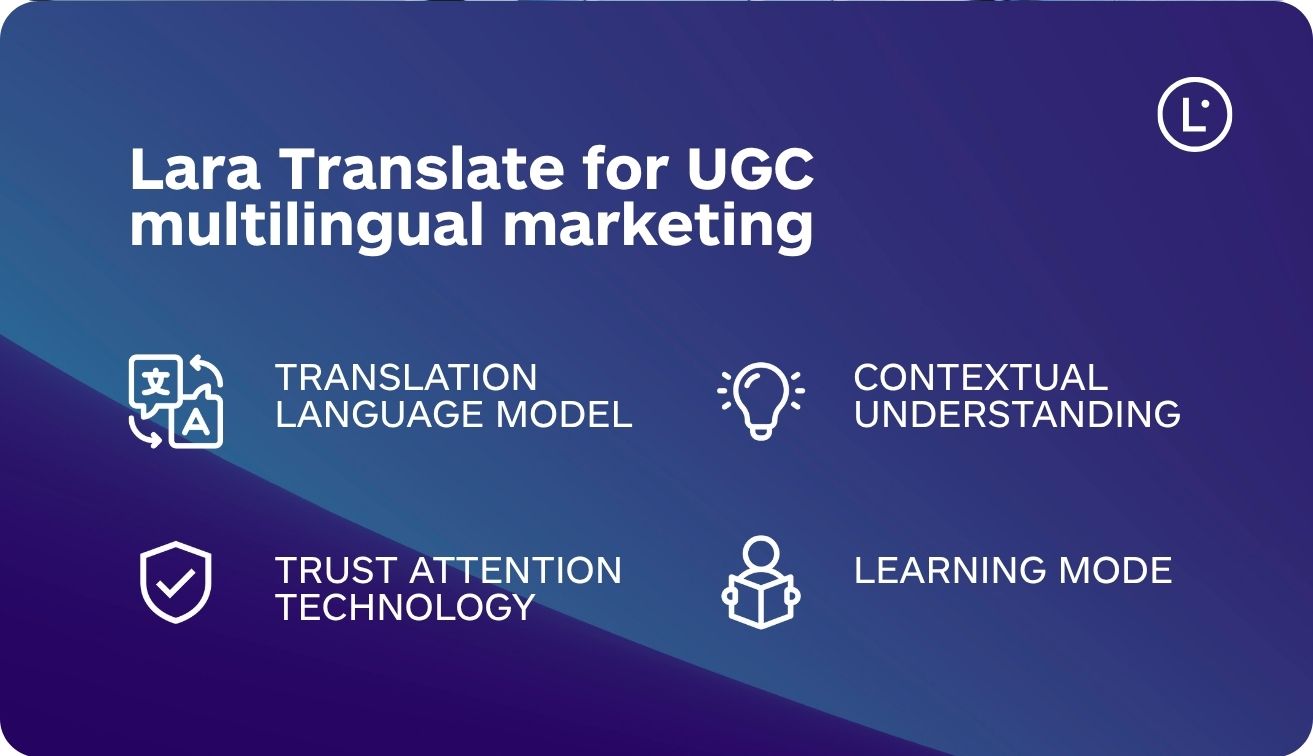
This specialized approach delivers particularly strong results for user-generated content, where maintaining the original tone and emotional impact is crucial. Lara Translate’s Trust Attention technology evaluates source data based on reliability, ensuring translations draw from the highest-quality examples while preserving the authentic voice that makes UGC effective.
The platform’s contextual understanding enables consistent terminology management and brand voice across all markets, critical for maintaining coherent messaging throughout UGC campaigns. For organizations implementing multilingual UGC strategies, this consistency prevents the fragmentation that often occurs when different translation methods are applied across markets.
What makes Lara Translate especially valuable for ongoing UGC initiatives is its Learning Mode capability. As organizations gather insights about regional preferences and terminology through their UGC campaigns, these findings can be integrated directly into translation memories and glossaries. This creates a virtuous cycle where each piece of translated content improves the system’s understanding of market-specific nuances.
Try Lara for UGC Marketing Strategies
Implementing UGC multilingual marketing: technology requirements
Successfully executing these strategies requires the right technological foundation. Organizations should evaluate their tech stack against these key requirements:
Translation and localization capabilities
Essential capabilities include:
- machine translation engines trained on conversational language
- human-in-the-loop workflows for review and refinement
- ability to preserve formatting and media elements across languages
- support for all target markets and languages
Content management and rights tracking
Effective UGC multilingual marketing requires robust systems for:
- tracking content rights across languages
- managing permission workflows in multiple languages
- organizing content by language, region, and usage rights
- connecting related content across language barriers
These systems ensure that organizations can efficiently manage UGC across languages while maintaining appropriate compliance.
Analytics and performance measurement
Measuring success requires analytics platforms capable of:
- tracking performance across languages and regions
- comparing engagement metrics between original and translated content
- identifying regional variations in content performance
- attributing conversion value to UGC across the customer journey
With these capabilities in place, organizations can continuously refine their UGC multilingual marketing strategies based on actual performance data.
Measuring success in UGC multilingual marketing
To evaluate the effectiveness of UGC multilingual marketing initiatives, organizations should track metrics across several key dimensions.
Engagement and reach metrics
Compare engagement across markets:
- content interaction rates (likes, shares, comments)
- time spent engaging with UGC
- scroll depth and attention metrics
- social amplification by market
These metrics help identify which approaches are resonating most effectively with each audience.
Conversion impact
Analyze how translated UGC influences customer decision-making:
- conversion rates when UGC is present vs. absent
- impact of translated vs. original-language UGC
- influence on average order value
- effect on return purchase rates
These measurements demonstrate the tangible business impact of UGC multilingual marketing investments.
Brand perception shifts
Monitor how UGC affects brand perception in different markets:
- brand sentiment analysis across languages
- trust and credibility metrics
- customer feedback on UGC initiatives
- competitive perception comparisons
These indicators help organizations understand how UGC multilingual marketing is shaping their brand position in each market.
Building a sustainable UGC multilingual marketing program
Implementing these seven strategies creates the foundation for a sustainable, scalable approach to UGC across languages. To maximize long-term success, organizations should focus on building systems rather than one-off campaigns.
Understanding how to use UGC in multilingual campaigns best practices requires a systematic approach that includes:
- establishing clear governance models for UGC across markets
- developing training programs for regional teams
- creating standardized workflows that can be replicated across languages
- building measurement frameworks that enable cross-market comparison
- implementing continuous improvement processes based on performance data
By treating UGC multilingual marketing as an ongoing program rather than a project, organizations can realize compounding benefits as their content ecosystem grows across languages.
Organizations that successfully implement these strategies can transform user voices into powerful marketing assets that resonate authentically across languages and cultures. By respecting both linguistic nuance and cultural context, brands can build meaningful connections with global audiences through the authentic voices of their customers.
FAQs
How can brands maintain authenticity when translating user-generated content?
Preserving authenticity in UGC translation requires a careful balance. Technologies like Lara Translate that specialize in conversational language can maintain casual speech patterns while ensuring accuracy. When possible, having translations reviewed by native speakers familiar with both languages helps preserve cultural nuances and emotional resonance.
What are the most important legal considerations for multilingual UGC campaigns?
Organizations must navigate varying rights management requirements, disclosure regulations, and privacy laws across markets. Key considerations include obtaining appropriate permissions for both original content and translations, implementing market-specific disclosure requirements, and ensuring compliance with regional data privacy regulations.
How can smaller organizations implement UGC multilingual marketing with limited resources?
Smaller organizations should start by prioritizing their most strategic markets rather than attempting global coverage immediately. Lara Translate offers an ideal solution, as its AI-powered platform delivers near-professional quality translations without the expense of large translation teams. Its Learning Mode capability enables organizations to build market-specific knowledge over time, creating a scalable approach that grows with the business. Combining Lara Translate with selective human review for high-visibility content and community translation programs can help smaller organizations achieve enterprise-level results within realistic budget constraints.
Which types of UGC work best for multilingual campaigns?
Visual content like product demonstrations and before/after images often translates well across cultures with minimal adaptation. Straightforward testimonials about product functionality also work effectively across languages. Content that relies heavily on cultural references, humor, or idiomatic expressions may require more substantial adaptation for different markets.
How should organizations prioritize languages for UGC translation?
Organizations should prioritize languages based on market opportunity, current customer base, and strategic growth plans. Analyzing web traffic, existing customer demographics, and market potential helps identify which languages will deliver the greatest return on investment for UGC multilingual marketing efforts.
This article is about
- Multilingual UGC strategy development and how to create comprehensive frameworks for collecting, translating, and displaying user-generated content across multiple languages and cultural contexts
- Authenticity preservation and techniques for maintaining the genuine voice and emotional impact of user content when translating it for different markets
- Cross-language moderation and methods for ensuring UGC meets brand standards and regulatory requirements across diverse linguistic and cultural environments
- Cultural adaptation and approaches to customizing UGC presentation based on regional preferences and cultural expectations
- Specialized translation technology and how purpose-built solutions like Lara Translate address the unique challenges of UGC multilingual marketing with AI trained specifically for preserving conversational language nuances
Have a valuable tool, resource, or insight that could enhance one of our articles? Submit your suggestion
Useful articles
- Website localization best practices: an actionable guide
- Translation tools for social media: how to expand your audience globally
